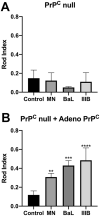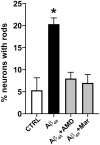Direct interaction of HIV gp120 with neuronal CXCR4 and CCR5 receptors induces cofilin-actin rod pathology via a cellular prion protein- and NOX-dependent mechanism
- PMID: 33705493
- PMCID: PMC7951892
- DOI: 10.1371/journal.pone.0248309
Direct interaction of HIV gp120 with neuronal CXCR4 and CCR5 receptors induces cofilin-actin rod pathology via a cellular prion protein- and NOX-dependent mechanism
Abstract
Nearly 50% of individuals with long-term HIV infection are affected by the onset of progressive HIV-associated neurocognitive disorders (HAND). HIV infiltrates the central nervous system (CNS) early during primary infection where it establishes persistent infection in microglia (resident macrophages) and astrocytes that in turn release inflammatory cytokines, small neurotoxic mediators, and viral proteins. While the molecular mechanisms underlying pathology in HAND remain poorly understood, synaptodendritic damage has emerged as a hallmark of HIV infection of the CNS. Here, we report that the HIV viral envelope glycoprotein gp120 induces the formation of aberrant, rod-shaped cofilin-actin inclusions (rods) in cultured mouse hippocampal neurons via a signaling pathway common to other neurodegenerative stimuli including oligomeric, soluble amyloid-β and proinflammatory cytokines. Previous studies showed that synaptic function is impaired preferentially in the distal proximity of rods within dendrites. Our studies demonstrate gp120 binding to either chemokine co-receptor CCR5 or CXCR4 is capable of inducing rod formation, and signaling through this pathway requires active NADPH oxidase presumably through the formation of superoxide (O2-) and the expression of cellular prion protein (PrPC). These findings link gp120-mediated oxidative stress to the generation of rods, which may underlie early synaptic dysfunction observed in HAND.
Conflict of interest statement
The authors have declared that no competing interests exists.
Figures








Similar articles
-
Amyloid-β and proinflammatory cytokines utilize a prion protein-dependent pathway to activate NADPH oxidase and induce cofilin-actin rods in hippocampal neurons.PLoS One. 2014 Apr 23;9(4):e95995. doi: 10.1371/journal.pone.0095995. eCollection 2014. PLoS One. 2014. PMID: 24760020 Free PMC article.
-
gp120 induces cell death in human neuroblastoma cells through the CXCR4 and CCR5 chemokine receptors.J Neurochem. 2000 Jun;74(6):2373-9. doi: 10.1046/j.1471-4159.2000.0742373.x. J Neurochem. 2000. PMID: 10820198
-
HIV Associated Neurodegenerative Disorders: A New Perspective on the Role of Lipid Rafts in Gp120-Mediated Neurotoxicity.Curr HIV Res. 2018;16(4):258-269. doi: 10.2174/1570162X16666181003144740. Curr HIV Res. 2018. PMID: 30280668 Free PMC article. Review.
-
A double-mimetic peptide efficiently neutralizes HIV-1 by bridging the CD4- and coreceptor-binding sites of gp120.J Virol. 2014 Mar;88(6):3353-8. doi: 10.1128/JVI.03800-13. Epub 2014 Jan 3. J Virol. 2014. PMID: 24390333 Free PMC article.
-
Chemokine receptor utilization and macrophage signaling by human immunodeficiency virus type 1 gp120: Implications for neuropathogenesis.J Neurovirol. 2004;10 Suppl 1:91-6. doi: 10.1080/753312758. J Neurovirol. 2004. PMID: 14982745 Review.
Cited by
-
The Impact of Neurotransmitters on the Neurobiology of Neurodegenerative Diseases.Int J Mol Sci. 2023 Oct 19;24(20):15340. doi: 10.3390/ijms242015340. Int J Mol Sci. 2023. PMID: 37895020 Free PMC article. Review.
-
Neuropathogenesis of acute HIV: mechanisms, biomarkers, and therapeutic approaches.Curr Opin HIV AIDS. 2025 May 1;20(3):199-208. doi: 10.1097/COH.0000000000000923. Epub 2025 Mar 26. Curr Opin HIV AIDS. 2025. PMID: 40110851 Free PMC article. Review.
-
Metabolic Reprogramming in HIV-Associated Neurocognitive Disorders.Front Cell Neurosci. 2022 Mar 28;16:812887. doi: 10.3389/fncel.2022.812887. eCollection 2022. Front Cell Neurosci. 2022. PMID: 35418836 Free PMC article.
-
Potential molecular mechanisms of chronic fatigue in long haul COVID and other viral diseases.Infect Agent Cancer. 2023 Feb 7;18(1):7. doi: 10.1186/s13027-023-00485-z. Infect Agent Cancer. 2023. PMID: 36750846 Free PMC article. Review.
-
α-Synuclein triggers cofilin pathology and dendritic spine impairment via a PrPC-CCR5 dependent pathway.Cell Death Dis. 2024 Apr 13;15(4):264. doi: 10.1038/s41419-024-06630-9. Cell Death Dis. 2024. PMID: 38615035 Free PMC article.
References
-
- Bell JE. The neuropathology of adult HIV infection. Rev Neurol Paris. 1998;154: 816–29. - PubMed
Publication types
MeSH terms
Substances
Grants and funding
LinkOut - more resources
Full Text Sources
Other Literature Sources
Medical
Molecular Biology Databases

